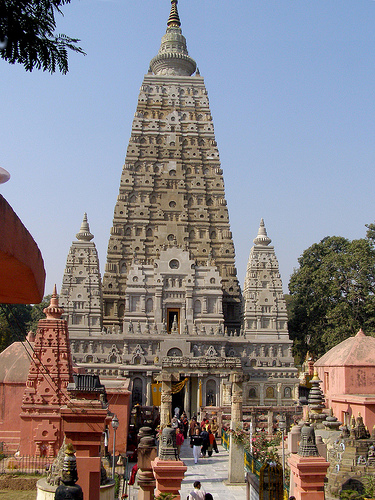

Location: Bihar State Map
Temple office (0631) 240 2445
Open: daily
Mahabodhi Temple is a medieval Buddhist temple located in Bihar State in India. The name of this religious complex is translated as the Great Enlightenment or Great Awakening. Buddhist tradition claims that it was here that prince Siddhārtha Gautama achieved enlightenment while sitting under a Bodhi tree. He subsequently received a respectful name Buddha or the Enlightened One. There is little evidence for an existence of this historical figure, but later documents claim that he lived either in the 6th or 5th century BC. Buddhist mythology also claims that this site will be the last to disappear with destruction of the World and will be the first to be recreated when the World will be reborn. The first attempt to mark this spot happened in 250 BC by Buddhist Emperor Asoka. He constructed a diamond throne here and named it Vajrasana. Stupa was constructed in the 5th century AD. During Medieval age religious complex was largely abandoned. Local dynasties that supplied this important religious complex with resources and cheap labor were defeated. It was visited by individuals, but complex was overgrown by a jungle. Only in the late 19th centuries it was re- discovered. Cleaning of the site began under British government and supervision of Sir Alexander Cunningham.
The Mahabodi Temple is a 55 m high brick building dating from the 1st
to 3rd centuries AD. The external facade includes seven steps and is
decorated with numerous Buddha statues. The frieze, which runs around
the base of the temple on three sides, depicts 85 sandstone Buddhas from
the Sunga period (1st century BC). Inside the temple there is a
gold-plated statue of the meditating Buddha. On the north side of the
temple extends the Jewel Path (Chankramanar), which consists of 19 stone
lotuses that mark the path where, according to tradition, Buddha
practiced walking meditation in the second week after his Bodhi
experience. The temple courtyard houses numerous stupas.
On the
west side of the pyramid-shaped large stupa is the sacred Mahabodhi, a
poplar fig (ficus religiosa, also Bodhi tree), which, according to
tradition, is a descendant of the tree under which Siddhartha Gautama
attained Bodhi. Beneath the Bodhi Tree, the Diamond Throne (Vajrasana),
a red sandstone platform, marks the site where he sat for meditation.
Around 250 BC, the Buddhist ruler Ashoka visited Bodhgaya with the
intention of creating a place of remembrance there. Ashoka had the Bodhi
tree surrounded by a stone fence and marked the sacred place with an
edict pillar with an elephant capital. Both have not been preserved.
In the Sunga period, an open pavilion with stone pillars was built
around the Bodhi tree and the Diamond Throne was created. The Mahabodhi
Temple was built during the Kushana period in the 2nd century. The older
part of the temple is made of sandstone. In 625, the temple and the
original Mahabodhi tree fell victim to destruction during a military
campaign by the Bengal King Shashanka. A little later, the younger part
of the temple was rebuilt from coarse granite. The Mahabodhi tree, which
was newly planted at the time and still exists today, is an offshoot of
the Sri Mahabodhi in Anuradhapura (Sri Lanka), which in turn was a tree
built in the 3rd century BC. It is a cutting of the original tree
brought to Sri Lanka by Sangamitta, King Ashoka's daughter, in the 4th
century BC. Around the year 635, the Chinese monk Xuanzang visited the
temple during his pilgrimage and left a description of the place in his
travelogue.
After being destroyed, the temple had to be
fundamentally restored or rebuilt several times. For centuries, the
temple in Bodhgaya was one of the major Buddhist pilgrimage
destinations, visited by monks from all the countries where Buddhism had
spread. In the 12th and 13th centuries, restorations were carried out by
Burmese, who also built the four small towers at the corners of the
large stupa.
With the conquest of large parts of the Indian
subcontinent by Muslim rulers (cf. Mughal Empire) from the 12th century
and the resurgence of Hinduism, the Mahabodhi Temple was ultimately
forgotten and partially fell into disrepair. It was only in the late
19th century that Buddhists, again from Burma, managed to agree with the
British colonial rulers that the temple should be restored as a Buddhist
sanctuary. The restoration work was completed in 1889.
After India's independence in 1949, a committee was appointed by
Parliament to manage the shrine's administration together with the Bihar
government. The temple management committee, consisting of four
Buddhists and four Hindus, first met in 1953. In 1973, a “Buddha Gaya
Temple Advisory Board” was formed, consisting of 21 members from
different nations. Long-standing efforts by Buddhist monks to have a
Buddhist chair the temple management committee initially failed due to
the legal situation, as the Temple Management Act of 1949 stipulated
that only a Hindu could chair the committee. Since an amendment to the
law in 2013, the head of the Gaya district can now head the committee,
even if he is not a Hindu.
UNESCO added the temple to the World
Heritage List in June 2002.
On July 7, 2013, unknown persons
carried out a multiple bomb attack on the Mahabodhi temple complex,
which was little visited that day, a Karmapa monastery school and other
targets in Bodhgaya. Two monks were injured. In August 2013, the Indian
Ministry of Home Affairs responded to a request from the Bihar
government to provide special units of the Indian Federal Police (CISF)
to protect the UNESCO World Heritage Site. The Mahabodhi Temple is the
only religious site in India that receives protection from special units
of the federal police. In November 2013, the Indian government agency
“National Investigation Agency” announced that the Islamist terrorist
group “Indian Mujahideen” was responsible for the attack.